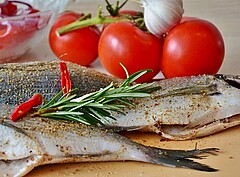Occurrence of halogenated compounds in food fishes from Southern Brazil. [02.10.18]
Halogenated natural products (HNPs) are possibly toxic compounds that may bioaccumulate and biomagnify along the food web and pose a further risk to human and environmental health. The present study analyzed the occurrence of HNPs in the edible muscle of the three most consumed commercial fish species in the state of Rio de Janeiro: sardine (Sardinella brasiliensis), whitemouth croaker (Micropogonias furnieri) and mullet (Mugil liza) from the highly polluted Guanabara Bay (GB) and the less polluted Ilha Grande Bay (IGB).Originalpublikation
Estrella, L. F.; Ferreira, V. B.; Gallistl, C.; Alves, M. G.R.; Vetter, W.; Malm, O. et al. (2018): Occurrence of halogenated natural products in highly consumed fish from polluted and unpolluted tropical bays in SE Brazil. In: Environmental Pollution 242, S. 684–691. DOI: 10.1016/j.envpol.2018.07.030.
Author information:
1 Federal University of Rio de Janeiro (UFRJ), Radioisotopes Laboratory Eduardo Penna Franca, Institute of Biophysics Carlos Chagas Filho, Av. Carlos Chagas Filho n. 373 Bl G ss 061, Rio de Janeiro, 21941-902, Brazil
2 Federal Rural University of Rio de Janeiro (UFRRJ), Post-Graduation Program in Food Science and Technology, Rodovia BR 465 Km 7, Seropédica, 23890-000, Brazil
3 State University Centre of the Western Zone (UEZO), Post-Graduation Program in Environmental Science and Technology, Avenida Manuel Caldeira de Alvarenga, 1203, Rio de Janeiro, 23070-200, Brazil
4 University of Hohenheim, Institute of Food Chemistry, Garbenstraße 28, Stuttgart, 70599, Germany
5 Federal University of Tocantins (UFT), Food and Nutrition Security Laboratory, Quadra 109 Norte, Avenida NS-15, ALCNO-14, Palmas, 77001-090, Brazil
Abstract
Natural compounds from the metabolism of marine organisms have been detected at high concentrations in environmental samples which are not the producers of these compounds. These natural substances are known as halogenated natural products (HNPs). HNPs are possibly toxic halogenated compounds analogous to POPs that may bioaccumulate and biomagnify along the food web and pose a further risk to human and environmental health. The present study analyzed the occurrence of HNPs in the edible muscle of the three most consumed commercial fish species in the state of Rio de Janeiro: sardine (Sardinella brasiliensis), whitemouth croaker (Micropogonias furnieri) and mullet (Mugil liza) from the highly polluted Guanabara Bay (GB) and the less polluted Ilha Grande Bay (IGB). The analytical steps included Soxhlet extraction, clean-up step and injection in a gas chromatography system coupled to a mass spectrometer operated in the electron-capture negative ion mode (GC/ECNI-MS). The compounds 2,4,6-TBP, 2,4,6-TBA, MHC-1, Q1, 6-MeO-BDE 47 and 2′-MeO-BDE 68 were found in the analyzed fish from both studied areas. Q1, 6-MeO-BDE 47 and 2′-MeO-BDE 68 showed the highest concentrations in samples. Q1 concentrations in the sardines from IGB were higher than the sardines from GB (p < 0.05) and higher than the other IGB species (p < 0.05). The differences found among the species may be related to their characteristic habitat and diet. It is noteworthy that most of these compounds do not have any toxicological reference value. Moreover, the HNPs are being detected in species of low trophic level and since this study has worked only with commercial species, these fish may be considered as a source for human exposure to these natural compounds.


